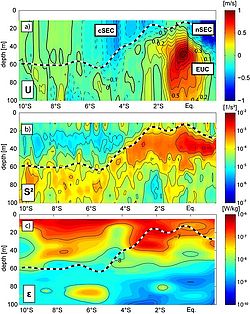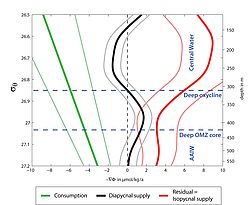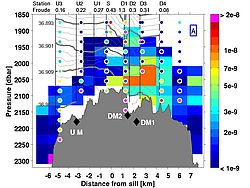Ocean mixing
Small-scale mixing processes are an essential component of the ocean circulation and the ocean‘s climate. Mixing processes transport heat, salt and other dissolved substances between layers of different densities. The associated diapycnal heat flux is an important driver of the meridional overturning circulation and impacts heat uptake by the ocean. Mixing processes also contribute to the uptake and emission of anthropogenic greenhouse gases and play an important role in biogeochemical cycling of carbon and nutrients. Within physical oceanography, we aim at advancing the understanding of mixing processes in the ocean and developing physically-based parameterizations needed for improving ocean and climate models.
The strength of ocean mixing varies over several orders of magnitude. Elevated mixing rates are found at the ocean boundaries where energy input by the winds and tidal energy is predominately dissipated. Other “hot spots” for mixing processes include mid-ocean ridges and seamounts, the Southern Ocean and the upper equatorial oceans.
GEOMAR has established comprehensive infrastructure for integrated ocean mixing observations. The temporal and spatial variability of mixing can be observed by particularly fast-sampling microstructure probesMicrostructure. These probes are used as loosely-tethered profilers or are mounted to gliders and other autonomous underwater vehicles (AUVs). An accurate method to determine temporally and spatially averaged mixing rates are deliberate tracer release experiments.
Selected results:

- Mixing processes and sea surface temperature in the equatorial Atlantic
The ocean has a major influence on tropical Atlantic climate variability. This is most noticeable in the close link between interannual variability of sea surface temperature in the upwelling regions and rainfall variability in the tropical Atlantic. To elucidate the role of mixing processes for the seasonal surface layer heat budget, an extensive microstructure measurement campaign consisting of 11 cruises to the central and eastern equatorial Atlantic was conducted. The results showed that the heat flux due upper-ocean mixing processes is a key factor controlling sea surface temperature in the equatorial upwelling region (Hummels et al., 2013). Mixing is particularly elevated from June through September, leading to an enhanced diapycnal heat flux from the surface to the upper thermocline. This surface layer heat loss strongly contributes to the seasonal evolution of the equatorial upwelling during the boreal summer months. The elevated mixing is caused by instability developing in the strongly sheared zonal current system at the equator.
- Mixing and oxygen supply to oxygen minimum zones
How does oxygen supply to oxygen minimum zones work? A weak circulation in the upwelling regions of the eastern tropical oceans and enhanced primary production lead to the formation of oxygen minimum zones (OMZs), for example in the northern Atlantic Ocean off northwest Africa. To advance understanding of the role of mixing processes in maintaining OMZs, a measurement program was conducted consisting of a deliberatetracer release experiment (GUTRE) and microstructure measurements. This data set allowed quantifying oxygen fluxes into the OMZ due to turbulent mixing for the first time. The data analysis revealed that about 1/3 of the total oxygen supply to the OMZ is achieved by turbulent mixing processes (Banyte et al., 2012; Fischer et al., 2013). However, it was also shown that the oxygen supplied to the OMZ does not originate from the surface waters within the OMZ region. Weak eastward currents above the OMZ transport oxygen-rich waters from the western tropical Atlantic towards the OMZ region. This lateral-advective oxygen transport provides the oxygen source for the mixing processes.
- Mixing in a rift valley of the Mid-Atlantic Ridge
In the deep ocean, mixing over rough topography, for example above mid-ocean ridges, is strongly elevated compared to mixing over abyssal plains. To advance understanding of the physical processes contributing to elevate mixing over rough topography, a measurement campaign was conducted in the rift valley of the mid-Atlantic ridge in the Lucky Strike segment near 37°N. In the experiment, a horizontally profiling microstructure probe attached to an autonomous under water vehicle was used to infer the spatial distribution of the dissipation rate of turbulent kinetic energy (ε). The experiment marked the first successful realization of a horizontal, deep-ocean microstructure survey. In the rift valley, a mean upslope (northward) current having velocities between of 3-8 cm/s was observed. Elevated mixing rates were repeatedly measured downstream of a sill within the rift valley (Tippenhauer et al., 2015). Combined with observed vertical density displacements within the sill, a hydraulic jump was detected to occur at the sill that also contributed to elevated mixing downstream of the sill.
Publications
Banyte, D., T. Tanhua, M. Visbeck, D. W. R. Wallace, J. Karstensen, G. Krahmann, A. Schneider, L. Stramma and M. Dengler (2012), Diapycnal diffusivity at the upper boundary of the tropical North Atlantic oxygen minimum zone, J. Geophys. Res., 117, C09016, doi: 10.1029/2011JC007762.
Fischer, T., D. Banyte, P. Brandt, M. Dengler, G. Krahmann, T. Tanhua, and M. Visbeck (2013) Diapycnal oxygen supply to the tropical North Atlantic oxygen minimum zone, Biogeosciences, 10, pp. 5079-5093, doi: 10.5194/bg-10-5079-2013.
Hummels, R., M. Dengler, and B. Bourlés (2013), Seasonal and regional variability of upper ocean diapycnal heat flux in the Atlantic Cold Tongue, Prog. Oceanogr., 111, 52-74, doi: 10.1016/j.pocean.2012.11.001.
Tippenhauer, S., M. Dengler, T. Fischer, and T. Kanzow (2015) Turbulence and finestructure in a deep ocean channel with sill overflow on the Mid-Atlantic Ridge, Deep-Sea Res. I, 99,10-22, doi: 10.1016/j.dsr.2015.01.001




